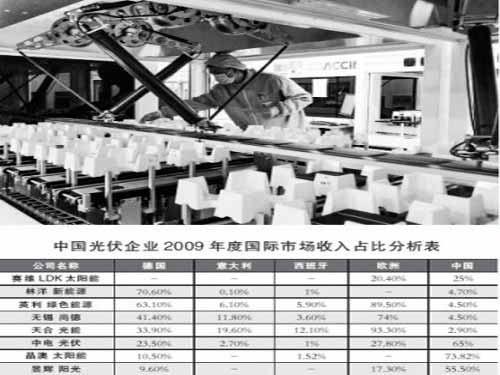
As we all know, the development of the photovoltaic industry is inseparable from the government subsidies. Japan's subsidy policy has made Sharp. Germany's subsidy policy has made Q-cell a success. China's Wuxi government has supported Wuxi Suntech. However, Germany, the largest photovoltaic market this year, announced for the first time the reduction of PV subsidies, which will hit the PV industry.
It is reported that in July of this year, the German Federal Senate passed the “Renewable Energy Law Photovoltaic Power Generation Internet Access Subsidy Amendmentâ€. From July 1, 2010, the amount of subsidy for rooftop photovoltaic power generation systems built in Germany has decreased by 13%. After the original non-power station land was converted to power station land, the subsidy amount was reduced by 8%, and the subsidy in other areas was reduced by 12%. From October 1, 2010, the subsidy will be reduced by another 3% on the basis of July 1.
The reduction of German subsidies has caused widespread concern in the photovoltaic industry, because this move not only caused Germany to begin looting, but is even more worrying whether many Chinese PV industries relying on the German market will suffer heavy losses. How much of China's PV companies derive their income from Germany? By sorting out the relevant data, we were pleasantly surprised to find that in the 2009 corporate income, the proportion of Germany has begun to decline, and there have been many new growth points, such as the United States, South Africa, Taiwan, India, and Southeast Asia. The table below is a table of the share of revenue sources of Chinese PV companies collected from the 2009 annual report.
As can be seen from the table, Linyang New Energy's share of revenue from Germany is the highest at 70.60%. Linyang New Energy mainly produces solar cells and sells them directly to system integrators. Its revenue from five major customers (Germany's Q-cell is one of them) accounted for 65.7% of total revenue in 2009. Revenue from the largest customer accounted for 40.6% of total revenue in 2009, and these proportions are yearly Increasing trend. In February 2008, the company also established a subsidiary in Germany to expand its European operations. From this we can see that Linyang New Energy is very dependent on Germany and other European countries and there is a great policy risk.
Trina Solar's highest share of revenue from Europe is 93.3%. Its revenue from the five largest customers accounted for 36.9% of total revenue in 2009, which was far lower than 65.7% of Linyang New Energy. Revenue from the largest customer, Invictus NV, accounted for 9.5% of total revenue in 2009, which is also far below the 40.6% of Linyang New Energy. It can be seen that although the market is mainly in Europe, Trina Solar has been expanding its markets in other European markets. Its customers in Europe are also located in Spain, Italy, France, the Benelux Economic Union, and the Czech Republic.
Trina Solar's share of the European market has remained stable. Although the reduction in Spanish government subsidies has caused Trina Solar's share in 2009 to drop sharply, at the same time, the share of other European markets has been almost in the past three years. The rise of the straight line.
Yingli Green Energy's share of income from Germany is also as high as 63.1%, and the share of income from Europe is as high as 89.5%. Although Yingli has always been known as the entire industry chain, according to the Yingli Annual Report, Yingli's products sold overseas are mainly photovoltaic cells. Its customers are also similar to Linyang New Energy and are mainly sold to system integrators. The domestic customers are mainly government departments, telecommunication broadcast companies and so on. It is no wonder that Yingli wants to sponsor the World Cup to expand its influence in Europe.
JA Solar's revenue from China accounted for a maximum of 73.82%. To see such a percentage, many people may have doubts. Is not that most of the customers of China's PV companies come from Europe?
In fact, we must pay attention to a problem here. Jingao is mainly engaged in the production of photovoltaic cells. JA Solar was established only in 2005. Currently, our customers are mainly domestic PV module manufacturers, and we are working hard to expand our business in overseas markets. According to the second quarter 2010 financial report, the proportion of income from China has dropped to 54%. It can be seen that Jinao is currently striving to develop European customers. Europe is still a fat sheep competing in the PV market.
In addition, recent news has been saying that Jingao intends to continue to expand its production capacity and set a target of 1.3 GW for PV cell shipments in 2010 to catch up with the industry leader Wuxi Suntech. Suntech Suntech is not only the leader in photovoltaic cells, but also the leader in the photovoltaic industry. In the first quarter 2010 financial report released, Wuxi Suntech's 2010 target for photovoltaic cell shipments was 1.3 GW. Due to the good market, Wuxi Suntech raised its expectations in the second quarter earnings report, and the target for shipment for the whole year was 1.5 GW. It seems that JA Solar needs to work harder if it wants to become the biggest in the photovoltaic cell industry.
Bidet Sprayer,Toilet Bidet Sprayer,Stainless Steel Bidet Kits,Non-Electric Toilet Bidet Sprayer
kaiping aida sanitary ware technology co.,ltd , https://www.aidafaucets.com